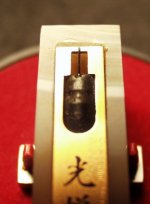lt cdr data said:Is generator droop caused by inductance? ie like a speaker bass filter in series?
No. For our purposes, the generator has two distinct parts; a mechanical system consisting of the cantilever plus stylus tip, and the electrical system consisting of the coils and their loading.
If the mechanical system has high effective mass (inertia), it will be more difficult to accelerate. Acceleration is proportional to frequency, so we have a mechanical low-pass filter. The more mass, the lower the frequency of the filter.
Conversely, the coil's inductance combines with load capacitance to form a resonant circuit that causes HF lift up to the resonant frequency. With suitable values, this lift can exactly compensate for the mechanical low-pass filter. That's why load capacitance is critical - only one value exactly matches the mechanical losses.
If the cat leaps up and pats the stylus, your cartridge is ruined. But it's unlikely to happen.
Unlikely, eh? You can see the missing tip on the pic. I'll refrain from posting a picture of the cat - it's also missing stuff now.
Attachments
If you had a test record that you believed with a a frequency sweep, you could display it on an oscilloscope at slow sweep speed, then try different values until you get the best response. Or you could just use the values the manufacturer specifies.
There's always one cat, isn't there?
There's always one cat, isn't there?
There is a disadvantage to peaking the frequency response by electrical resonance in the cartridge. If you simulate as a low pass filter you will see that at a Q of 0.5 there is no electrical overshoot and ringing on transients. At a Q of 0.707 there is just a tiny bit. at a Q of 1.0 it is quite noticable and at a Q of 2.0 it is bad. What you are doing is trading bandwidth extension for overshoot and ringing on transients.
This same problem exists in amplifiers when you try to extend the frequency response using a peaking coil. The theoretical maximum you can extend the response is by a factor of about 1.5, but you have a huge peak in the frequency response and terrible overshoot and ringing.
Regards,
Ray
This same problem exists in amplifiers when you try to extend the frequency response using a peaking coil. The theoretical maximum you can extend the response is by a factor of about 1.5, but you have a huge peak in the frequency response and terrible overshoot and ringing.
Regards,
Ray
Did you ever look at the response of most moving coils? Rrrrrrrrrrrrring a ding ding! They do it without the assistance of an electrical boost, but ringing is ringing.
Aye, there's the rub. Use two different good quality test records and you'll get two different frequency response curves. That's one reason I don't sweat getting that last 0.2dB of RIAA eq trimmed in....
If you had a test record that you believed
Aye, there's the rub. Use two different good quality test records and you'll get two different frequency response curves. That's one reason I don't sweat getting that last 0.2dB of RIAA eq trimmed in....
SY said:Did you ever look at the response of most moving coils? Rrrrrrrrrrrrring a ding ding! They do it without the assistance of an electrical boost, but ringing is ringing.
But the ringing is an octave+ above human hearing, and there's virtually nothing recorded at that frequency. The bad stuff with a MM occurs in the audible range, and in a FR with recorded musical content.
audiobomber said:
But the ringing is an octave+ above human hearing, and there's virtually nothing recorded at that frequency. The bad stuff with a MM occurs in the audible range, and in a FR with recorded musical content.
Well, I have to say that the worst ringing I've ever seen was from a MM (of sorts). Old timers will know exactly which idiosynchratic British cartridge I'm talking about. But I've seen very similar ringing with MCs- some are indeed in the ultrasonic range (though at 50 years old, everything above 14kHz is ultrasonic to me), but some are not. Denons are particularly ringy. I've never tested a Shure, but would like to if I ever get the chance. Basic math tells me that if the frequency response ends up flat up to 20kHz, whether by mechanical means, electrical means, or a combination, any ringing will be ultrasonic. And the response curves I've seen for the optimally-loaded Shure are indeed quite flat in the top octave.
OTOH, the single best square wave performances I've seen were from an optimally loaded Technics MM and a Dynavector MC. Go figure. In both cases, one could easily make out the ringing from the cutter head that made the test record. That's what we call "resolution."
According Fig. 2 under
Discussion on MC Cartridge Loading
there are some MC cartridges, which need like typical MM cartridges even additional capacitors up to 1,5uF and not only resistors as usual with most MC cartridge models.
I would be interested in which models and manufacturers this affects.
Thank you very much.
Discussion on MC Cartridge Loading
there are some MC cartridges, which need like typical MM cartridges even additional capacitors up to 1,5uF and not only resistors as usual with most MC cartridge models.
I would be interested in which models and manufacturers this affects.
Thank you very much.
- Home
- Source & Line
- Analogue Source
- moving coil loading
